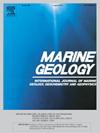姚江-宁波平原中全新世极端风暴事件的沉积记录与新石器文化响应
IF 2.2
3区 地球科学
Q2 GEOSCIENCES, MULTIDISCIPLINARY
引用次数: 0
摘要
中国东部姚江-宁波沿海平原是天然易受盐度入侵的地区。5.3 ka前后,研究区经历了一个极端风暴事件和相关盐度入侵特别频繁的时期(5.3 ka极端风暴期)。沉积记录在平原上广泛分布,但到目前为止还没有系统地合并,这限制了对这些极端风暴对史前沿海群落影响的解释。本文采用多指标分析方法,对位于瑶江-宁波平原新出土的新石器时代遗址虎坑集的5.3 ka极端风暴期剖面进行了年代学、沉积学和地球化学分析。古环境重建结果表明,该遗址约6.0 ka时为潮汐沼泽环境,约5.3 ka时为盐度入侵,5.1 ka时为河流洪水。通过与该地区其他沉积记录的对比,我们发现,耀江-宁波平原5.3 ka极端风暴期从约5.4 ka延伸至约4.9 ka,在5.3 ka和5.1 ka前后出现了两个高峰。河姆渡文化第四期的社区通过建造人工土墩来适应这一阶段的沿海洪水。然而,5.3 ka极端风暴时期的极端水文气候事件的影响最终导致河姆渡文化在整个地区被5.1 ka左右更复杂和社会分层的良渚文化所取代。本文章由计算机程序翻译,如有差异,请以英文原文为准。
Sedimentary records of mid-Holocene extreme storm events and Neolithic cultural response in the Yaojiang-Ningbo Plain, East China
The Yaojiang-Ningbo coastal plain in East China is naturally vulnerable to salinity intrusion. At around 5.3 ka, the study area experienced a period (the 5.3 ka extreme storm period) when extreme storm events and associated salinity intrusions were especially frequent. Sedimentary records are widely distributed in the plain but have thus far not been systematically amalgamated, constraining interpretation of the impacts of these extreme storms on prehistoric coastal communities. Here we present a multi-proxy analysis of the chronology, sedimentology, and geochemistry of a profile containing records of the 5.3 ka extreme storm period from a newly excavated Neolithic site, Hukengji, in the Yaojiang-Ningbo plain. Results of the paleoenvironmental reconstruction evidences a tidal marsh environment at the site at ca. 6.0 ka, which was exposed to salinity intrusions at ca. 5.3 ka and river flooding at ca. 5.1 ka. Through comparison with other sedimentary records in the region, we show that the 5.3 ka extreme storm period in the Yaojiang-Ningbo Plain extended from ca. 5.4 ka to ca. 4.9 ka, with two peaks at around 5.3 ka and 5.1 ka. Communities of the Hemudu Culture Period IV adapted to this phase of coastal flooding, for example, by constructing artificial mounds. However, the effects of the extreme hydroclimatic events during the 5.3 ka extreme storm period led eventually to the Hemudu Culture being replaced across the region by the more complex and socially stratified Liangzhu Culture from around 5.1 ka onwards.
求助全文
通过发布文献求助,成功后即可免费获取论文全文。
去求助
来源期刊

Marine Geology
地学-地球科学综合
CiteScore
6.10
自引率
6.90%
发文量
175
审稿时长
21.9 weeks
期刊介绍:
Marine Geology is the premier international journal on marine geological processes in the broadest sense. We seek papers that are comprehensive, interdisciplinary and synthetic that will be lasting contributions to the field. Although most papers are based on regional studies, they must demonstrate new findings of international significance. We accept papers on subjects as diverse as seafloor hydrothermal systems, beach dynamics, early diagenesis, microbiological studies in sediments, palaeoclimate studies and geophysical studies of the seabed. We encourage papers that address emerging new fields, for example the influence of anthropogenic processes on coastal/marine geology and coastal/marine geoarchaeology. We insist that the papers are concerned with the marine realm and that they deal with geology: with rocks, sediments, and physical and chemical processes affecting them. Papers should address scientific hypotheses: highly descriptive data compilations or papers that deal only with marine management and risk assessment should be submitted to other journals. Papers on laboratory or modelling studies must demonstrate direct relevance to marine processes or deposits. The primary criteria for acceptance of papers is that the science is of high quality, novel, significant, and of broad international interest.
 求助内容:
求助内容: 应助结果提醒方式:
应助结果提醒方式:


